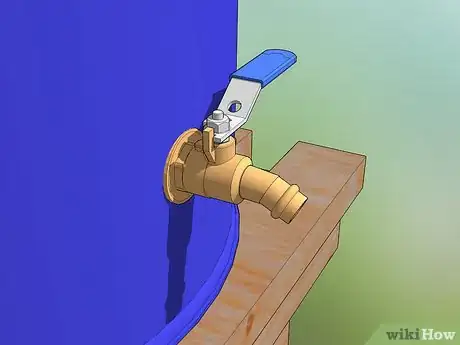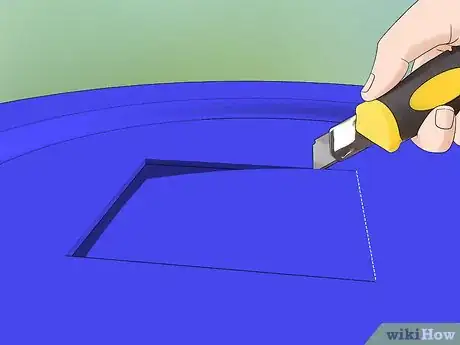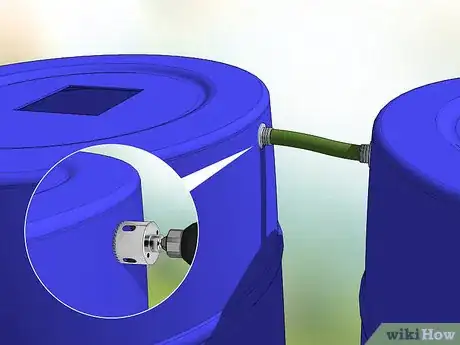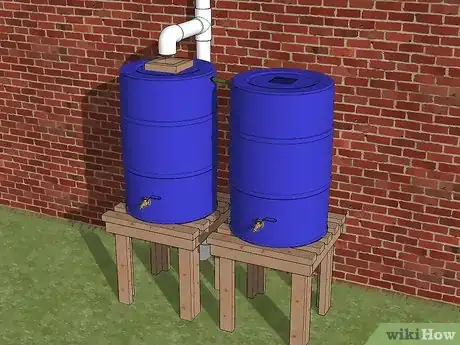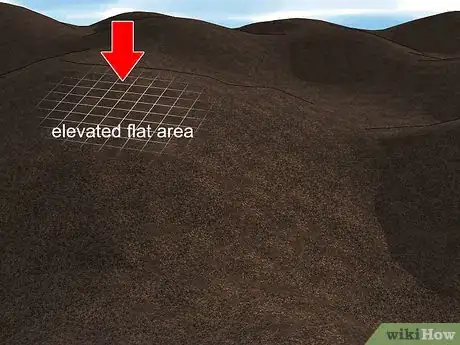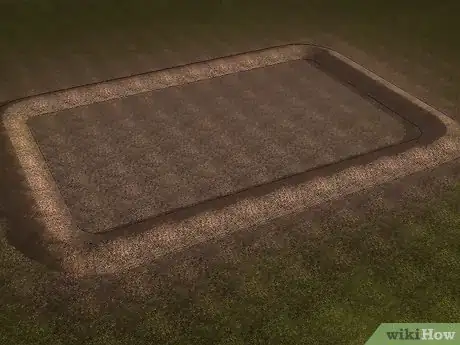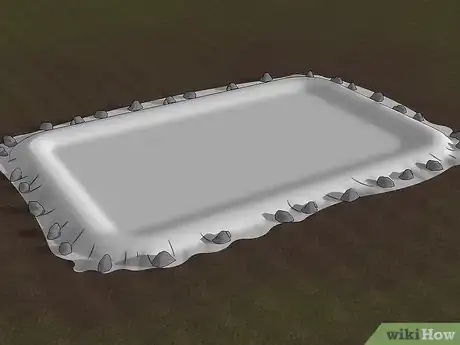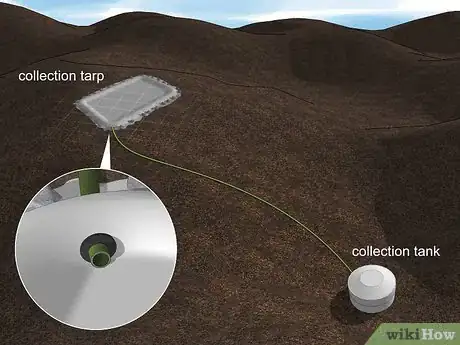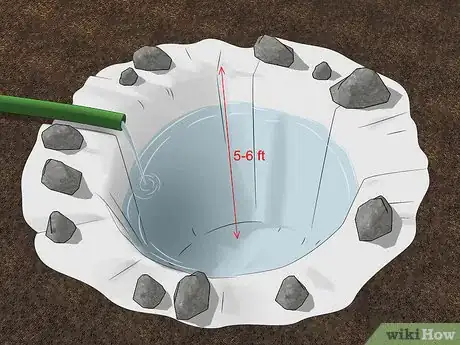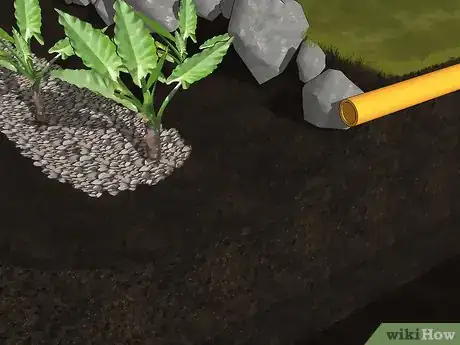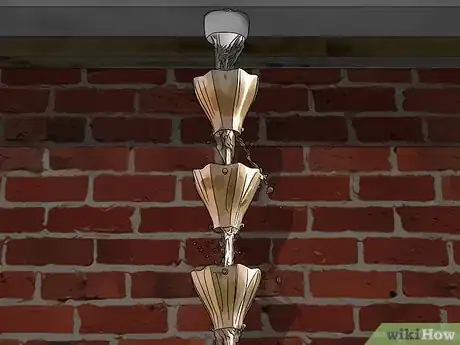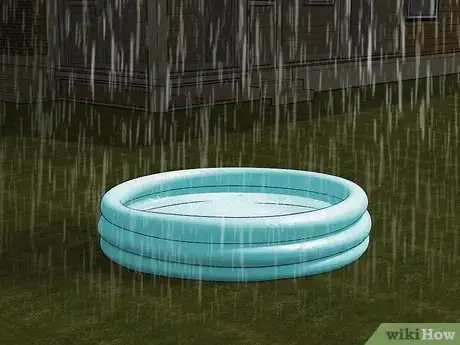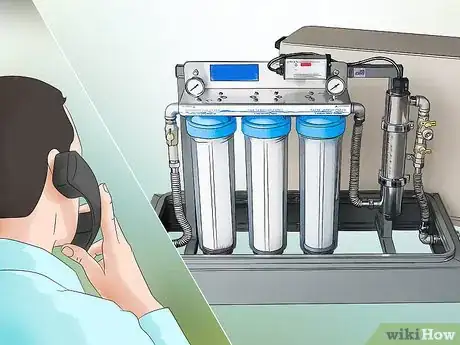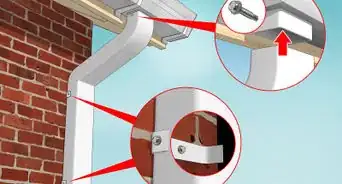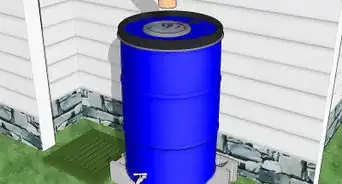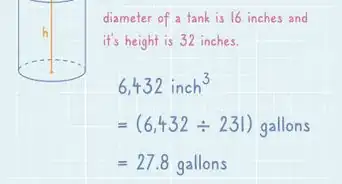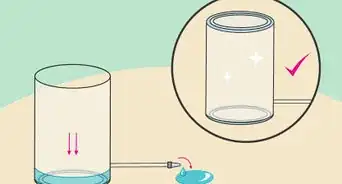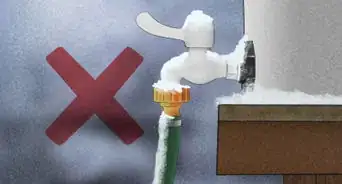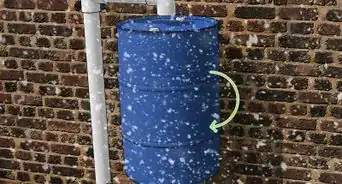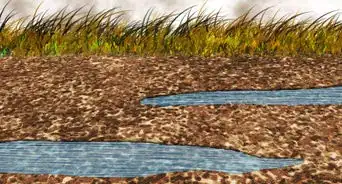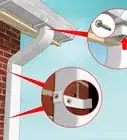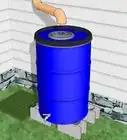This article was co-authored by Mike Garcia. Mike Garcia is a Licensed Landscape Contractor and the Founder of Enviroscape LA, a full-service landscape design and construction firm in Los Angeles, California. With over 30 years of experience, Mike specializes in sustainable landscape practices. Mike holds an Ornamental Horticulture degree, C-27 Landscape Contractor and D-49 Tree Service Contractor licenses, and Permaculture Design, California Naturalist, International Certified Professional Pond Contractor, and Pond Building certifications. He is one of eight Internationally Certified Pond Builders in the world. Enviroscape LA has won landscape and water feature awards from the International Professional Pond Contractors Association (IPPCA), National Association of Pond Professionals (NAPP), and the California Landscape Contractors Association (CLCA). Mike is a past president of the CLCA and currently serves on their local Board of Directors. Enviroscape LA has been featured in PONDS USA Magazine, Pond and Garden Lifestyles Magazine, and the Los Angeles Times. Mike has appeared on Extreme Home Makeover, HGTV's Landscapers Challenge, and A & E's series Fix That Yard.
There are 11 references cited in this article, which can be found at the bottom of the page.
This article has been viewed 267,136 times.
Collecting rainwater for home and landscaping use is a great way to save money and conserve water. Depending on the amount of rainfall your area receives, you may be able to collect enough for all of your water needs! Choose the right collection method for your lifestyle, such as a barrel for rooftop collection or a tarp to utilize a change in elevation. Then, carefully set up your system to harvest the rainwater as easily and efficiently as possible.
Steps
Making a Barrel to Collect Roof Water
-
1Make sure rain barrels are legal in your area before you start. Rain barrels, and rain collection in general, are illegal in some areas due to water rights restrictions. Before you start constructing your collection system, look online or contact your local government to see whether it’s legal in your area.[1]
In the US, nearly all states allow water collection and some even encourage it. However, in states like Nevada, rain water harvesting with rain barrels is illegal without a water right.[2]
-
2Drill a hole near the bottom of a large plastic garbage can. Use a hand drill to carefully drill a hole on the side of your garbage can, about 5 inches (13 cm) from the bottom. This hole will be used for your spigot, so make sure to use a drill bit that’s a little bit smaller than or the same size as the spigot.[3]
- You’ll use this spigot hole to extract water from the barrel, so make sure it’s not so low that you can’t slide a bucket or watering can under it.
- If you don’t want to make a water barrel, you can also purchase one online or from a home improvement store.
Advertisement -
3Attach a spigot over the hole with waterproof sealant. Slide a metal washer onto the screw end of the spigot, then fit a snug rubber washer on over the screws to prevent leakage. Apply a thick layer of waterproof sealant over the rubber washer, insert the spigot into the hole, and let it dry for as long as instructed on the package.[4]
- Once the sealant is dried, secure it on the inside of the barrel by sliding on another rubber washer and metal washer.
- If you don’t have waterproof sealant, you can also use watertight Teflon tape.
-
4Cut a hole in the lid to collect water from your home’s downspout. Use a box cutter to cut the collection hole, and make it big enough to accommodate the water flow from your downspout. Place it near the side of the lid, following the curve, so it can fit comfortably against the wall of your house.[5]
- Place the barrel under your downspout and make a mark on the lid for the hole location.
- Don’t place it too close to the center of the lid; if your downspout is against the side of your house, there won’t be enough room for you to place the hole directly under it.
-
5Make a second hole to release overflow. If the barrel collects a lot of rain, it’ll need an overflow opening to release the extra water. Using your drill or box cutter, cut 1-2 smaller holes in the lid to accommodate this extra flow.[6]
- If you want to collect the overflow water, build a second rain barrel. Run a short length of hose or PVC pipe from the second barrel to the overflow hole in the first barrel to allow the extra water to run through.
-
6Put landscaping fabric over the top to keep out pests. Before you secure the garbage can lid, cut a large piece of landscaping fabric and place it over the entire opening. Cut it large enough that about 1 foot (30 cm) of fabric sticks out over the can. Then, attach the lid to secure it in place.[7]
- Landscaping fabric is made of a fine mesh, which will allow water to pass through while keeping out mosquitoes and other pests.
- You can buy it online or at home improvement stores.
-
7Place the barrel under your downspout to collect rainwater for a home or garden. Now that your barrel is constructed, simply set it below your downspout to collect water.[8] To make it more convenient to use, create a small platform of bricks or another solid, durable material and set the barrel on top. This will give you more room to fill up water cans or buckets of water.[9]
- If you want to connect a hose to the spigot, raising the barrel up a bit will also give you more water pressure.
- If you use your water for gardening, you can pour it out of the spigot as-is. If you plan to use it for cooking, drinking, or cleaning, filter it first.
Collecting Rainwater with a Tarp
-
1Choose a collection site that’s slightly elevated. Choose a relatively flat area that’s elevated slightly above your storage area. You also want the collection area itself to slope just a bit towards the corner closest to the storage area, which ensures that the water won’t sit and stagnate as it collects. It should run towards this lower corner, then down the piping towards your storage area.[10]
Ensuring Elevation
Run a string line from your collection site to the storage area and secure it with stakes in the ground. Back up a few steps and make sure that you can see it sloping downwards.[11]
Tip: If the collection area doesn’t slope naturally towards one corner, work to lower it manually when you clear it. There only needs to be a few inches of slope to collect the water in one corner.
-
2Clear out a large section of ground on the higher elevation. As you clear the area of any plants and brush, stack extra dirt along the sides. This creates a border of berm edges that will help hold the water. Make sure that the area slopes just slightly towards the corner that’s closest to the downward slope.[12]
- Measure your tarp before you start clearing to make sure your area is large enough. Make it about 6 inches (15 cm) shorter than the tarp on all sides so you can pull the tarp over the bermed edges.
-
3Lay out a large tarp that covers the whole area. Lay out your tarp so that its edges lay over the bermed edges of your collection area. If you can, try to use a billboard tarp, which is around 20 in × 30 in (51 cm × 76 cm) in size, to collect as much rainwater as you can.[13]
- You can use a tarp of any size to collect rainwater, but a larger the surface area, the more water you’ll harvest.
-
4Place rocks along the tarp to keep it down in the wind. To ensure your tarp stays in place, evenly space large rocks along its surface. You should also shovel several inches of dirt onto the edges to keep them from flapping.[14]
-
5Run a drainpipe from the lowest corner of the tarp to the collection tank. Cut a hole through the lowest corner of the collection tarp, just large enough to fit the opening of your pipe through, then seal it over with waterproof sealant. Run the pipe down the slope to your collection tank. Use corner pipe attachments if you need to lift the water into the tank; the pressure should be high enough to pump it upwards on its own.[15]
- For the most storage, you can use a large IBC tote tank. You can also use a regular rain barrel or even make your own from a trash can.
- Use PVC drainpipe, which you can buy at a home improvement store. You can lay it flat on the ground, or dig a slight depression around it to keep it in place.
-
6Collect the water in a tarp-covered hole for a cheaper option. If you don’t want to buy a large storage tank, simply dig a deep hole, at least 5–6 ft (150–180 cm), into the ground and cover with with a tarp. Let the rain water collect there and extract it with a bucket as needed.
- If you use your water for gardening or other outdoor use, you can leave it as-is. If you plan to use the water for cooking, drinking, or cleaning, filter it first.
- Constructing this larger-scale tarp collection system will harvest the most water in the most efficient way. In a pinch, though, you can simplify the system by digging a wide hole in the ground and lining it with a tarp to catch rain.
Trying Alternative Collection Systems
-
1Build a rainwater garden to redirect water for landscaping. A rainwater garden uses runoff water from roofs and gutters to grow vegetation and flowers while filtering out harmful chemicals. You’ll need to clear out an area of your yard to create a depression that’s 3–4 ft (91–122 cm) deep and as long and wide as you have room for! Then, use piping to extend your downspout directly into the depression to provide water for the garden.[16]
- You can then plant native plants, flowers, or vegetables in your garden.
-
2Hang a rain chain from your gutter for a decorative option. A rain chain connects to the water flow in your gutter, redirecting it down a series of copper or metal cups for a pleasing waterfall effect. To use one, simply remove your gutter’s downspout and fasten the rain chain’s hook through the pipe. Place a rain barrel or another storage unit underneath the chain to collect the water.[17]
-
3Collect rainwater in household items for a cheap, convenient method. When all else fails, you can use everyday items around your house to collect rain. Although this won’t work as well for longer periods of time or larger water needs, using household items can work in a pinch or in an emergency.[18]
Collect water in:
An inflatable kiddie pool
Watering cans
PotsTip: Monitor larger items like kiddie pools and to make sure they don’t stay stagnant for too long and attract mosquitoes.
-
4Consider using a landscaping company to install a collection and filtration system. If you’re interested in a full water collection and filtration system for your home, the easiest option might be to get it installed by a landscaping company. They’ll be able to ensure that the collection system works without leakages and that it’s filtered properly for your use.
Community Q&A
-
QuestionHow can I make good use of rainwater?
 Community AnswerYou can use it to water plants, keep it in a bowl for stray birds, wash your car with it or for bathing your pets if you have any. These are just some of the things you can do with rainwater.
Community AnswerYou can use it to water plants, keep it in a bowl for stray birds, wash your car with it or for bathing your pets if you have any. These are just some of the things you can do with rainwater. -
QuestionWhat is used for purifying rain water?
 Community AnswerFor non-drinking purposes, such as bathing or clothes washing, running the water through charcoal and sand will clean it of most impurities. For drinking, additional purification is required through heating, chemical, ozonefiltering or other methods, in order to kill bacterial growth and pathogens.
Community AnswerFor non-drinking purposes, such as bathing or clothes washing, running the water through charcoal and sand will clean it of most impurities. For drinking, additional purification is required through heating, chemical, ozonefiltering or other methods, in order to kill bacterial growth and pathogens. -
QuestionHow can I feed the collected water to bore?
 Community AnswerThe water which you collected from the rain saucer, or from the roof of the house is supplied to the big containers with a pipe line and is connected to the bore.
Community AnswerThe water which you collected from the rain saucer, or from the roof of the house is supplied to the big containers with a pipe line and is connected to the bore.
Warnings
- Make sure that water collection is legal in your area before starting to harvest it.⧼thumbs_response⧽
Things You’ll Need
Rain Barrel Water Collection
- 1-2 large plastic garbage can
- Watertight sealant
- 2 rubber washers
- 2 metal washers
- Hose clamp
- Spigot
- Drill with large drill bits
- Landscaping fabric
Tarp Collection
- Shovel (to clear dirt)
- Large tarp (billboard size, if possible)
- PVC piping
- Storage unit (a tank or tarp-covered hole)
- String (to measure elevation change)
- Stakes (to measure elevation change)
References
- ↑ https://www.bhg.com/gardening/yard/tools/make-a-rain-barrel-save-water/
- ↑ https://www.rgj.com/story/news/2015/05/26/ask-rgj-can-nevadans-collect-rain-barrels/27983037/
- ↑ https://www.bhg.com/gardening/yard/tools/make-a-rain-barrel-save-water/
- ↑ https://www.bhg.com/gardening/yard/tools/make-a-rain-barrel-save-water/
- ↑ https://www.bhg.com/gardening/yard/tools/make-a-rain-barrel-save-water/
- ↑ https://www.bhg.com/gardening/yard/tools/make-a-rain-barrel-save-water/
- ↑ https://www.bhg.com/gardening/yard/tools/make-a-rain-barrel-save-water/
- ↑ Mike Garcia. Licensed Landscape Contractor. Expert Interview. 20 November 2020.
- ↑ https://www.bhg.com/gardening/yard/tools/make-a-rain-barrel-save-water/
- ↑ https://www.youtube.com/watch?v=WFey0NUXAVc&feature=youtu.be&t=2m43s
- ↑ https://www.youtube.com/watch?v=WFey0NUXAVc&feature=youtu.be&t=3m48s
- ↑ https://www.youtube.com/watch?v=WFey0NUXAVc&feature=youtu.be&t=2m43s
- ↑ https://www.youtube.com/watch?v=WFey0NUXAVc&feature=youtu.be&t=3m11s
- ↑ https://www.youtube.com/watch?v=WFey0NUXAVc&feature=youtu.be&t=3m18s
- ↑ https://www.youtube.com/watch?v=WFey0NUXAVc&feature=youtu.be&t=3m30s
- ↑ https://www.youtube.com/watch?v=V1S_qVwzfsA&feature=youtu.be&t=1m50sM
- ↑ https://www.youtube.com/watch?v=A_PkvWoHfoo&feature=youtu.be&t=14s
- ↑ https://thesurvivalmom.com/preparedness-uses-kiddie-pools/
About This Article
To collect rainwater, you can attach a rain barrel to your home's downspout so when it rains the water flows directly into the barrel. If you want to collect rainwater without a roof or downspout, you can use a tarp instead. Just lay the tarp out on an elevated area and run a drainpipe from the lowest corner to a collection tank. For smaller amounts of rainwater, you can put out pots, watering cans, or even an inflatable kiddie pool whenever it rains. To learn how to redirect rainwater to your garden, scroll down!


